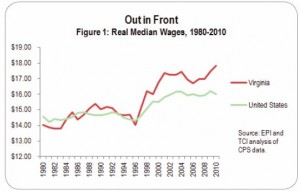In its latest study, “Unbalanced, Unequal and Undercut: The State of Working Virginia,” the Commonwealth Institute (CI) has picked a timely topic, conducted some excellent research, displayed some fascinating Virginia-specific data…. and created a terribly misleading impression.
The center-left think tank reports that wages in Virginia have rebounded from the recession more robustly than in other states. Median individual wages increased to $17.83 an hour in 2010, roughly 11% above the national average and the 8th highest of any state. Moreover, since the start of the downturn in 2007, median wages have increased by about 5% in real terms — the fourth highest increase in the nation.
Why has Virginia out-performed the nation? That might make interesting reading. But CI chooses to pursue a different story line: how the gap between high- and low-wage workers in the Old Dominion is wide and getting wider. In 2010, the top 10% of wage earners in Virginia earned about 5.7 times the wages of the bottom 10% — the widest gap of any state, save New Jersey.
Moreover, while wages may be picking up in the current business cycle, almost all the gains are going to people with more education and in higher-paying industries. “Between 1980 and 2010, the real wages of the top 10 percent of workers in Virginia increased by more than 52 percent,” write the authors. “Median wages, on the other hand, grew by just over half that much (27 percent) — and wages for the bottom 10 percent of workers increased by just five percent.”
Clearly, when viewed as a statewide phenomenon, the wage gap is alive and well in Virginia. But what does it all mean? Here’s what CI says:
The nature of these imbalances represent major setbacks for large segments of working Virginia, creating significant and growing distance between poverty and prosperity in the state. While it is encouraging that Virginia is adding more high-wage jobs, the high concentration of job losses in mid-wage industries since the start of the recession presents real challenges for Virginia’s middle class workers and should inform the discussion around what policies to implement in order to expand this critical segment of Virginia’s economy.
 Maybe, maybe not. As CI also notes, average weekly wages vary widely across Virginia — from a high of $1,264 in Northern Virginia to a low of $611 in Danville. Moreover, wages have been recovering significantly faster in Northern Virginia than in the rest of the state (excepting only the Winchester and Bristol metropolitan statistical areas). As CI concedes, Northern Virginia with its huge and wealthy population “distorts” the statewide average weekly wage.
Maybe, maybe not. As CI also notes, average weekly wages vary widely across Virginia — from a high of $1,264 in Northern Virginia to a low of $611 in Danville. Moreover, wages have been recovering significantly faster in Northern Virginia than in the rest of the state (excepting only the Winchester and Bristol metropolitan statistical areas). As CI concedes, Northern Virginia with its huge and wealthy population “distorts” the statewide average weekly wage.
I would put it differently: It is silly to look at Virginia as a single, unified labor market and bemoan the income disparities within it. A huge amount of the statewide disparity — and the increase in that disparity — can be attributed to different regional income dynamics. Northern Virginia is one of the highest-income regions of the entire country. No other Virginia region comes close. At the same time, Northern Virginia is also the most expensive region in Virginia in which to live. Adjusted for cost of living, the disparity in living standard between NoVa and Danville is significantly less than two to one. But CI’s metrics don’t account for cost of living.
CI could have emphasized a very different narrative: Northern Virginia, where incomes (and the cost of living) is highest, is creating more jobs than other regions of the state. Because these jobs tend to require higher levels of education and more demanding technical skills, they pay more. As a result, the growing statewide disparity in incomes is to some considerable degree explained by Northern Virginia’s success, not a growing disparity within regions. Is Northern Virginia’s triumph a bad thing for downstate Virginians? It’s not as if the region’s prosperity comes at the Rest of Virginia’s expense. In fact, NoVa contributes disproportionately to the cost of running state government. RoVa residents have every reason to be thankful.
The Commonwealth Institute study is well worth perusing. It contains loads of data useful for understanding the wealth gap in Virginia, such as it is. Just don’t get sucked into its woe-is-me worldview.





